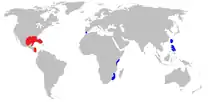Atlantic sixgill shark
The Atlantic sixgill shark (Hexanchus vitulus) is a rare species of hexanchid shark found in the Atlantic Ocean. It was formerly described as its own species, but was synonymised with the bigeye sixgill shark (Hexanchus nakamurai). However, a study published in 2019 resurrected the species on the basis of molecular data. The species can be physically differentiated from the bluntnose sixgill shark (Hexanchus griseus) by its much smaller size and position of the dorsal fin in relation to the caudal fin.[1][2] The Atlantic sixgill shark (Hexanchus vitulus) becomes sexually mature at around 1.40 to 1.75 meters. They do not reach lengths much greater than 180 cm. [3] Resurrection of the sixgill shark Hexanchus vitulus Springer & Waller, 1969 (Hexanchiformes, Hexanchidae), with comments on its distribution in the northwest Atlantic Ocean, 2018.
| Atlantic sixgill shark | |
|---|---|
| Scientific classification | |
| Kingdom: | Animalia |
| Phylum: | Chordata |
| Class: | Chondrichthyes |
| Superorder: | Selachimorpha |
| Order: | Hexanchiformes |
| Family: | Hexanchidae |
| Genus: | Hexanchus |
| Species: | H. vitulus |
| Binomial name | |
| Hexanchus vitulus Springer and Waller, 1969 | |
 | |
| Distribution of Hexanchus vitulus (red) and Hexanchus nakamurai (blue) | |
References
- Daly-Engel, T. S., Baremore, I. E., Grubbs, R. D., Gulak, S. J., Graham, R. T., & Enzenauer, M. P. (2019). Resurrection of the sixgill shark Hexanchus vitulus Springer & Waller, 1969 (Hexanchiformes, Hexanchidae), with comments on its distribution in the northwest Atlantic Ocean. Marine Biodiversity, 49(2), 759-768.
- "New species of shark discovered through genetic testing". Retrieved 4 March 2018.
- Springer, S., & Waller, R. A. (1969). Hexanchus vitulus, a new sixgill shark from the Bahamas. Bulletin of Marine Science, 19(1), 159-174. From using 1,310 base pairs of two mitochondrial genes, COI and ND2, it is confirmable that bigeye sixgill sharks from the Atlantic Ocean (Belize, Gulf of Mexico, and Bahamas) branched out from those in the Pacific and Indian Oceans (Japan, La Reunion, and Madagascar) having 7.037% sequence divergence.